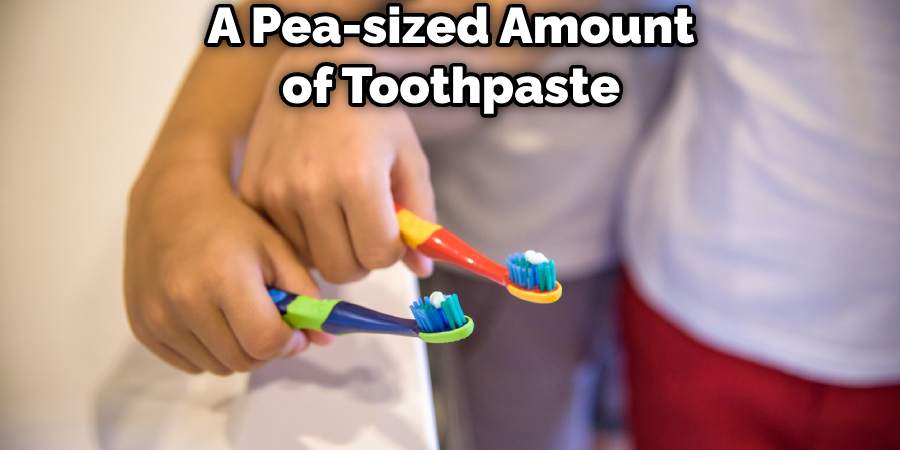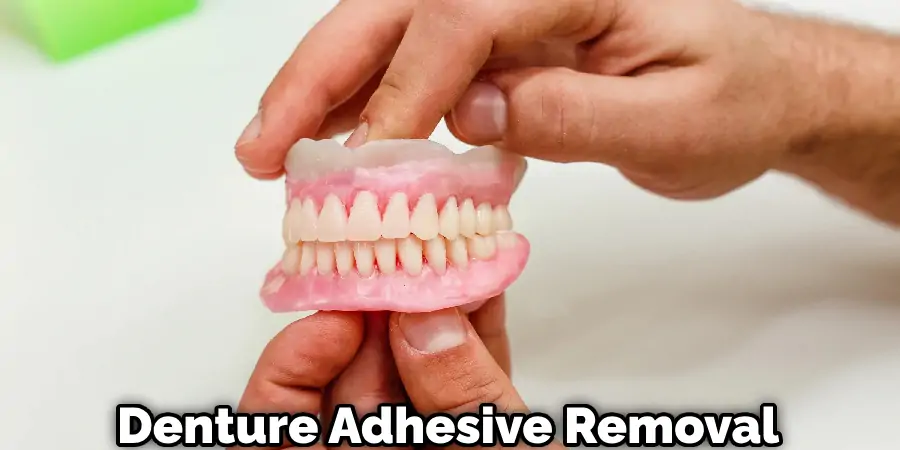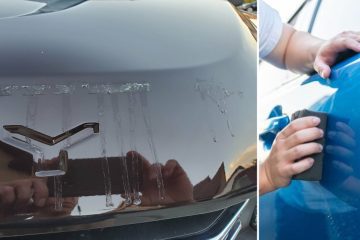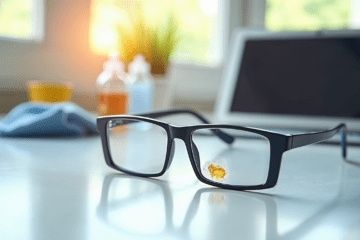Using denture adhesives can be a game-changer for denture wearers, providing much-needed stability, confidence, and improved chewing ability. However, removing the sticky residue left behind can be a daunting task that many struggle with. Fear not! We’ve compiled the ultimate guide on how to get denture glue out of your mouth effortlessly, ensuring a clean and comfortable mouth.

Key Takeaways:
- Removing denture adhesive residue is crucial for oral hygiene and comfort.
- Several effective methods include warm water rinses, salt water solutions, mouthwash, soft brushing, and commercial removers.
- Proper timing, massaging gums, and consulting professionals for persistent issues are essential tips.
Understanding Denture Adhesives
Denture adhesives come in various forms – creams, powders, and adhesive pads – and are designed to create a secure seal between your dentures and gums. While they offer numerous benefits, such as improved denture retention and stability, removing the residual adhesive can be a hassle if not done properly.
Why Remove Denture Adhesive Residue?
Leaving denture adhesive residue in your mouth can lead to several issues that can impact your oral health and overall denture experience:
- Impaired Oral Hygiene: Adhesive buildup can harbor bacteria, leading to potential infections, unpleasant odors, and gum irritation.
- Discomfort: The sticky residue can cause discomfort when speaking or eating, making it challenging to enjoy your meals fully.
- Interference with New Adhesive: Residual adhesive can prevent new applications from forming a proper seal, reducing the effectiveness of the adhesive and compromising the fit of your dentures.
Preparing for Denture Adhesive Removal
Before you begin the removal process, it’s essential to gather the necessary supplies and prepare a clean workspace. This may include warm water, salt, mouthwash, a soft-bristled toothbrush, and any commercial denture adhesive removers you plan to use. Additionally, read and follow the manufacturer’s instructions carefully for the best results.

5 Tried-and-true Methods for How to Get Denture Glue Out of Your Mouth
Here are some tried-and-true methods for how to get denture glue out of your mouth:
Method 1: Warm Water Rinse
One of the simplest yet effective methods is to rinse your mouth with warm water. Take a sip, swish it around vigorously for 30 seconds to a minute, and spit it out. Repeat this process a few times until the adhesive loosens, and you can easily remove it from your gums and dentures.
Method 2: Salt Water Solution
Mixing half a teaspoon of salt in a glass of warm water can create a saline solution that helps break down the adhesive. Rinse your mouth with this solution, allowing it to work its magic before spitting it out. The salt can help dissolve the adhesive completely, making it easier to remove from your dentures and gums.
Method 3: Mouthwash
Certain antibacterial mouthwashes can effectively dissolve and loosen denture adhesive while freshening your breath simultaneously. Look for mouthwashes containing ingredients like alcohol or essential oils, which can help break down the adhesive. Swish the mouthwash around your mouth before rinsing.
Method 4: Soft-bristled Toothbrush
For stubborn adhesive residue, a soft-bristled toothbrush can be your best ally. Gently brush your gums, palate, tongue, and the surfaces of your dentures with a pea-sized amount of toothpaste. This gentle scrubbing action can remove any remaining adhesive while promoting good oral hygiene.

Method 5: Denture Adhesive Removers
Several commercial denture adhesive removers are available on the market, designed specifically to dissolve and aid in the removal of adhesive residue. These products often come in the form of sprays or gels and can be applied directly to the affected areas before rinsing. Follow the instructions carefully for optimal results.
You Can Check It Out to Get Braces Glue Off Your Teeth.
5 Advanced Tips and Tricks for How to Get Denture Glue Out of Your Mouth
- Using the Right Amount of Adhesive: Using excessive denture adhesive can lead to oozing and make removal more challenging. Follow the manufacturer’s instructions or consult your dentist for the appropriate amount to use for your fitted dentures.
- Timing the Removal Process: Removing your dentures and adhesive residue at night before bedtime allows your gums to rest and recover, promoting better oral health. This break from dentures is essential for maintaining healthy gum tissues.
- Gently Massaging the Gums: After removing your dentures, use your fingertips or a soft cloth to gently massage your gums. This can help loosen any remaining adhesive and improve blood circulation to the area.
- Combining Methods for Stubborn Residue: If you encounter particularly stubborn adhesive residue, don’t hesitate to combine multiple methods. For example, you can rinse with warm water, follow up with a salt water solution, and then gently brush with a soft toothbrush for a thorough clean.
- Consulting a Dentist for Persistent Issues: If you find yourself constantly struggling with denture adhesive removal or experience persistent discomfort or irritation, it’s crucial to consult your dentist. They may recommend adjustments, relining, or alternative solutions for a better fit and improved denture experience.
You Can Check It Out What Can You Use Instead of Denture Glue?

Maintaining Denture Hygiene
Proper denture hygiene is essential for maintaining good oral health and preventing issues like bacterial buildup, staining, and foul odors. In addition to removing adhesive residue, it’s crucial to clean your dentures regularly using a soft-bristled brush and a recommended denture cleanser. Follow a consistent cleaning routine, and be sure to remove your dentures at night to allow your gums to rest.
When to Seek Professional Help
While denture adhesives can provide temporary relief for ill-fitting dentures, prolonged use may indicate the need for professional attention. If you notice signs of persistent discomfort, irritation, or a significant change in the fit of your dentures, it’s time to schedule an appointment with your dentist. Regular dental check-ups are also recommended to ensure the continued health and proper fit of your dentures.

FAQs About How to Get Denture Glue Out of Your Mouth
What Removes Denture Glue From Mouth?
To remove denture glue from the mouth effectively and gently, start with a warm water rinse to soften the adhesive. Follow up by using a soft-bristled toothbrush and toothpaste to brush your gums, palate, and tongue lightly. A saltwater rinse can also help in loosening the adhesive, and rinsing with mouthwash may further assist in the removal process. For the dentures themselves, rubbing off any remaining adhesive under warm running water with a damp exfoliating glove can be effective. These methods prioritize the health of your gums and the care of your dentures simultaneously.
What Dissolves Dental Glue?
To dissolve dental glue safely, professional debonding agents used by orthodontists are the most effective and safest option, as they’re specifically formulated to break down the adhesive without damaging tooth enamel. For at-home methods, oil-based products like eucalyptus oil or a weak vinegar solution can help soften the glue, but their effectiveness may vary, and they should be used with caution. Mechanical removal using dental picks and scalers is also an option, though best performed by professionals to prevent damage to the teeth. It’s crucial to avoid using harsh chemicals like acetone inside the mouth due to potential harm and irritation to oral tissues.
Does Denture Adhesive Dissolve in Water?
Denture adhesive does not fully dissolve in water. These adhesives are designed to be water-resistant so that they can maintain their hold throughout the day, including during eating and drinking. However, warm water can help soften denture adhesive, making it easier to remove from both the dentures and the mouth. For complete removal, physical cleaning with a soft brush or specialized denture cleaning products is usually necessary.
Conclusion
Removing denture adhesive residue is an essential part of maintaining good oral hygiene and ensuring a comfortable denture experience. By following the effective methods outlined in this guide, such as warm water rinses, salt water solutions, mouthwash, soft-bristled brushing, and commercial removers, you can easily and efficiently remove adhesive from your dentures and gums.
Remember, it’s essential to use the right amount of adhesive, time the removal process properly, and consult a professional if you encounter persistent issues. With a little patience and the right techniques, you can say goodbye to sticky denture adhesive residue and enjoy a clean, comfortable mouth every day.


